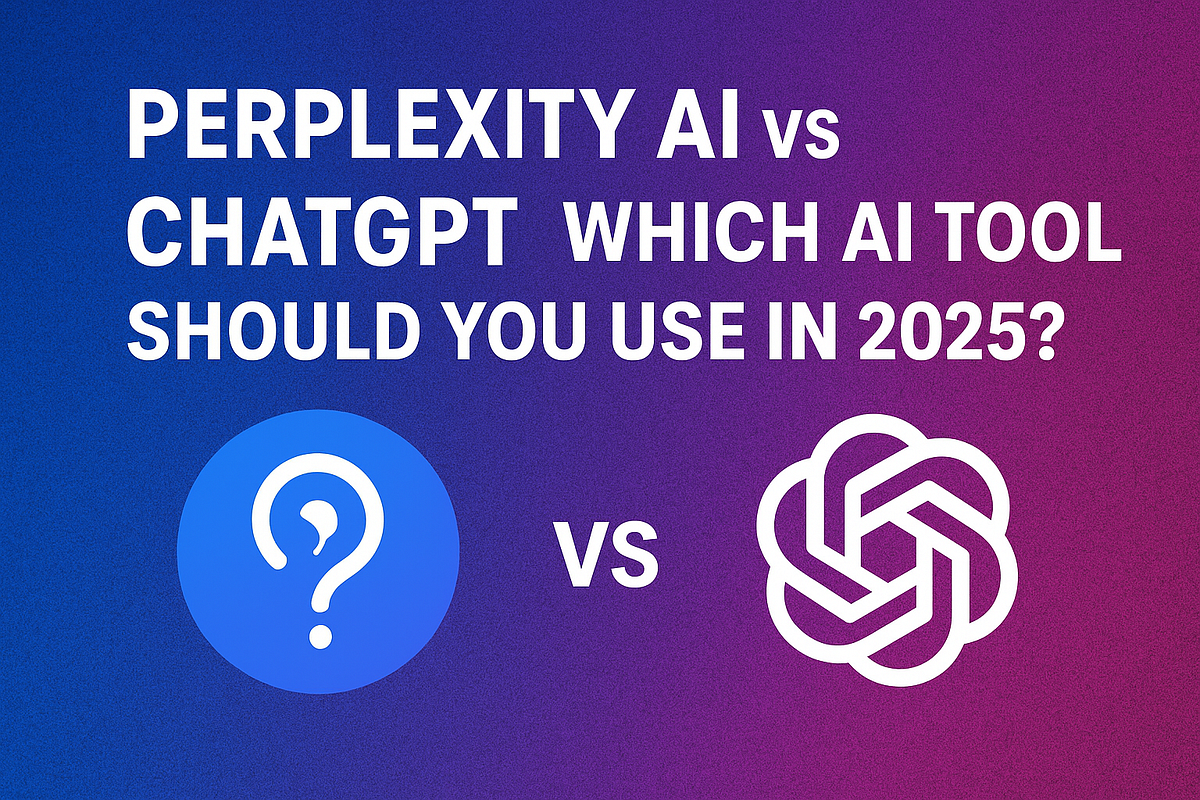Choosing between Perplexity AI and ChatGPT can be confusing. At first glance, both tools let you ask questions and get AI-generated answers. But the way they work — and the problems they’re designed to solve — are very different.
- Perplexity AI is built for real-time research. It pulls information directly from the web, provides citations, and gives you short, factual answers.
- ChatGPT is designed as a conversational assistant. It helps you write, brainstorm, code, and generate creative or structured content.
In this guide, we’ll break down the differences between Perplexity AI and ChatGPT, highlight their strengths and limitations, and show you exactly when to use each tool.
What is Perplexity AI?
Perplexity AI is best described as an AI-powered search engine with a conversational interface. Instead of giving you a long list of links like Google, it searches the web, summarizes the results, and cites sources directly in its answers.
This makes it ideal for fact-based, time-sensitive queries where accuracy and verification matter.
Key Features of Perplexity AI
- Real-time search: Pulls data live from the web.
- Citations included: Always provides references so you can fact-check.
- Concise results: Prioritizes clear, short answers instead of long text dumps.
- Conversation-friendly: Lets you ask follow-up questions without restarting your search.
- Cross-platform: Available via web and mobile apps.
Example Use Cases
- A law student researching recent Supreme Court rulings.
- A journalist fact-checking statistics for a breaking news article.
- A medical researcher looking up the latest clinical trial results.
👉 Best for: Students, researchers, professionals who need accurate, sourced, and current information.
What is ChatGPT?
ChatGPT, created by OpenAI, is a conversational AI assistant. Unlike Perplexity AI, it isn’t focused on citations or real-time data — it’s built to help you think, write, and create.
ChatGPT generates responses based on its training data (up to a certain knowledge cutoff). In some versions, it can also access the web and plugins for more updated results.
Key Features of ChatGPT
- Creative writing: Generates blog posts, essays, scripts, social media captions, and more.
- Coding help: Writes, explains, and debugs code in multiple languages.
- Idea generation: Brainstorms business strategies, project ideas, or study outlines.
- Conversational depth: Offers long-form, nuanced discussions instead of one-line answers.
- Customizability: Can adjust tone, style, and level of detail.
Free vs Paid Versions
- Free ChatGPT (GPT-3.5): Relies on pre-trained data. Great for general use but doesn’t always have real-time updates.
- ChatGPT Plus (GPT-4): Offers more accurate, nuanced answers and may include web browsing and plugin support, depending on availability.
Example Use Cases
- A content marketer generating 30 Instagram captions in under 5 minutes.
- A software developer using ChatGPT to debug Python code.
- A student asking ChatGPT to summarize a 40-page article into key takeaways.
👉 Best for: Professionals, creators, developers, and anyone who needs conversation, writing, or problem-solving support.
When to Use Perplexity AI
Use Perplexity AI when accuracy and recency are non-negotiable.
Best Situations
- Fact-Checking: Confirming details for a report or presentation.
- Research Projects: Academic papers, dissertations, or case studies requiring references.
- News & Current Events: Staying up to date on global developments.
- Professional Reports: Collecting statistics, data points, or official documents.
Example
- A policy analyst preparing a brief on renewable energy regulations passed in 2025.
- A student citing scientific studies from the past year in a research paper.
👉 If you need accuracy + citations, Perplexity AI is the right choice.
When to Use ChatGPT
Use ChatGPT when you need depth, creativity, or structured outputs.
Best Situations
- Writing & Content Creation: Drafting blogs, scripts, essays, or ad copy.
- Coding & Debugging: Writing functions, explaining algorithms, or fixing bugs.
- Brainstorming: Generating fresh ideas for marketing, projects, or personal goals.
- Summarizing & Productivity: Condensing long documents, planning workflows, or writing proposals.
Example
- A marketing team using ChatGPT to turn Perplexity AI research into a polished thought-leadership blog.
- A startup founder asking ChatGPT to draft a pitch deck outline.
- A teacher using ChatGPT to create lesson plans tailored to student needs.
👉 If you need conversation, creativity, or structured output, ChatGPT is the better tool.
Which One Should You Choose?
The real answer: You don’t have to choose — they work best together.
- Start with Perplexity AI → gather reliable, cited information.
- Move to ChatGPT → turn that raw research into content, code, or insights.
Rule of Thumb
- Choose Perplexity AI if you need facts, citations, and updates.
- Choose ChatGPT if you need conversation, creativity, and polish.
By combining both, you can cover the entire workflow:
- Research with Perplexity.
- Create with ChatGPT.
Conclusion
Perplexity AI vs ChatGPT isn’t really a competition — it’s a partnership.
- Perplexity AI acts as your AI-powered researcher, always ready with factual, cited, and current answers.
- ChatGPT serves as your AI collaborator, helping you write, code, brainstorm, and communicate effectively.
Think of it this way:
- Perplexity AI is the librarian who gives you the right books and sources.
- ChatGPT is the co-author who helps you turn that knowledge into something useful.
👉 Use both together, and you’ll unlock the full potential of AI — research that’s accurate, paired with output that’s polished and practical.
